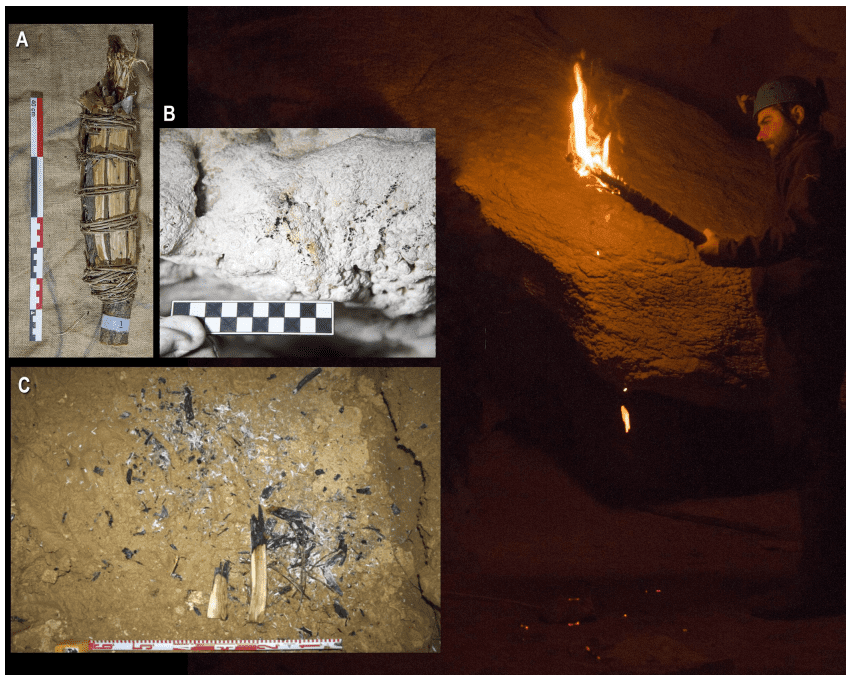
For early hunter-gatherer groups fortunate enough to live close to caves, these natural underground dwellings offered perfect shelter that could be defended against predators and rivals and that were shielded from inclement weather. Humans in the Paleolithic (also known as the Old Stone Age, spanning from around 30,000 BCE until 10,000 BCE) would spend a lot of time in these caves, cooking food, fashioning tools, and spending the night before heading out to restock supplies the next day.
When dusk came, however, these people were not left completely in the dark. Charcoal and murals etched on the walls of deep galleries where there was never sunlight suggest that some hunter-gatherers employed lighting systems to illuminate their cave dwellings.
Now, in a new study, researchers in Spain have recreated three common Stone Age lighting systems — torches, grease lamps, and fireplaces — in order to get a better understanding of what it must have been like living and working in these environments.
“The artificial lighting was a crucial physical resource for expanding complex social and economic behavior in Paleolithic groups, especially for the development of the first palaeo-speleological explorations and for the origin of art in caves,” noted Mariángeles Medina-Alcaide from the University of Cantabria, Spain, and colleagues, in a new study published this week in the journal PLOS ONE.
Based on archaeological evidence found across several Paleolithic caves in Southwest Europe, the team manufactured five replicated torches made from ivy, juniper, oak, birch, and pine resins; two stone lamps that burn animal fat, namely bone marrow from cows and deer; and a small fireplace out of oak and juniper wood.
Each lighting system had particular qualities and drawbacks, which prompted cave dwellers to use them across different contexts. For instance, the wooden torches assembled from multiple sticks had a light intensity almost five times greater than a double-wicked grease lamp. The torches lasted for an average of 41 minutes (the shortest-lived torch burned for 21 minutes while the longest-burning torch stayed blazed for 61 minutes), making them ideal for exploring caves. The light emanating from the torches projected light in all directions up to almost six meters, making them great for wider spaces.
However, the torches required close supervision as they extinguished easily. The handler had to constantly wag the torch back and forth to increase oxygen flow and ensure the torch stayed lit. But their main disadvantage was the amount of smoke they generated, which could cause trouble in tighter galleries of a cave.
Grease lamps are ideal for lighting small spaces over a long period. The light intensity they generate is very similar to that of a candle, projecting light up to three meters. Multiple such lamps could light a larger room. However, the lamps weren’t well suited to transiting due to their dazzling effect and poor floor illumination. They burned for well over an hour though.

Finally, the researchers also made a fireplace. This static system is perhaps the easiest and most readily available lighting system there is. The fireplace burned very smokily inside the cave and was extinguished after just 30 minutes. Air currents in the cave would make fireplace illumination unsuitable inside a cave network.
This investigation is important from many standpoints and may serve to shed light on many behavioral aspects of Paleolithic people. Because there were no written records left, scientists can only speculate on how ancient people lived based upon fragmentary evidence, like following a trail of breadcrumbs.
For instance, some stone age cave paintings have been etched hundreds of meters deep inside caves. They likely used some sort of combination of torches and lamps, and this lighting must have influenced the artistic process by altering color perception. As luminosity decreases, the human retina loses sensitivity to short wavelengths (green, blue, and purple), and then to long wavelengths (yellow, orange, and red).
Thus, red is best seen in low light conditions. The perception of colors also depends on the color temperature of the light; under incandescent or warm light (between 1000 and 2000 K), such as firelight, a yellow hue is emitted, and colors tend to appear more vivid.
“In any case, our experiments on Paleolithic lighting point to planning in the human use of caves in this period and the importance of lighting studies to unravel the activities carried out by our ancestors in the deep areas of caves,” wrote the authors.


